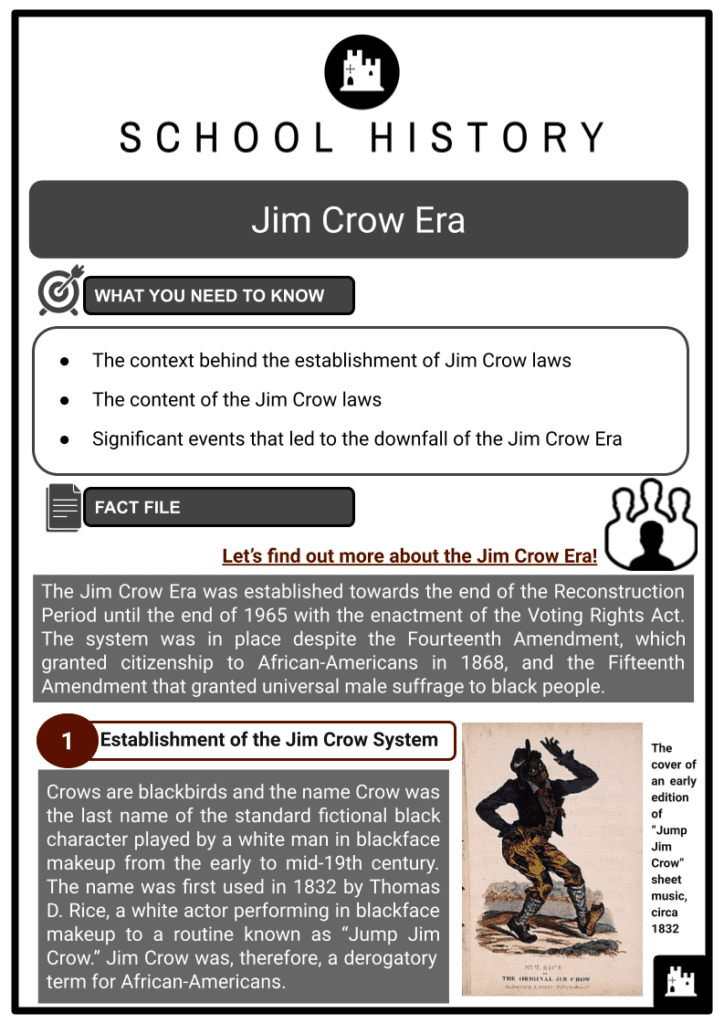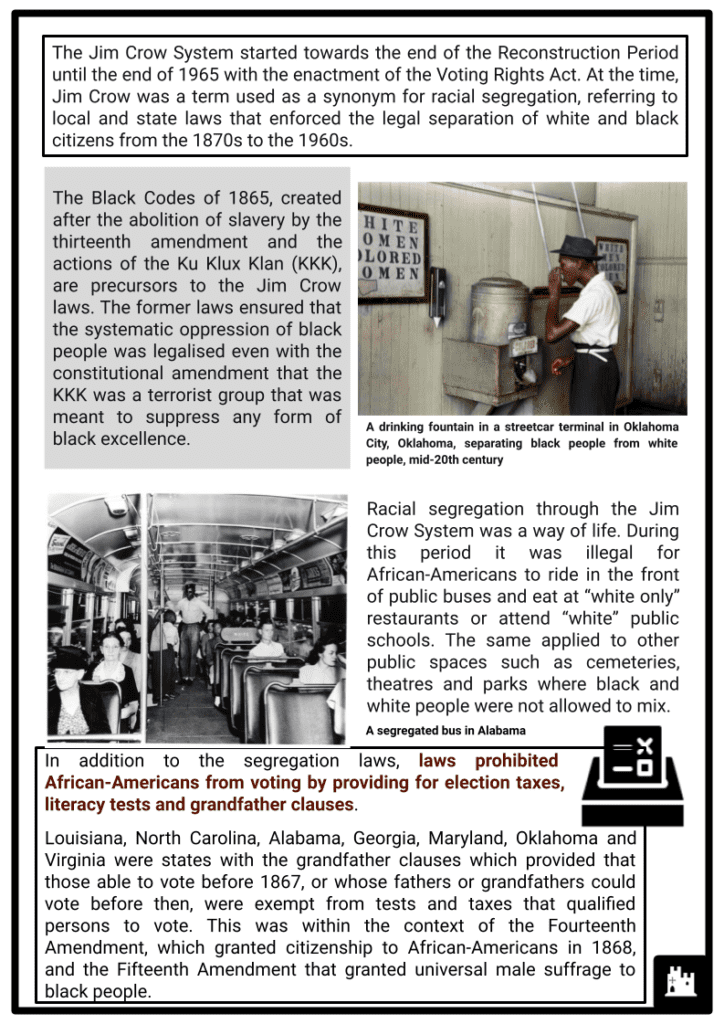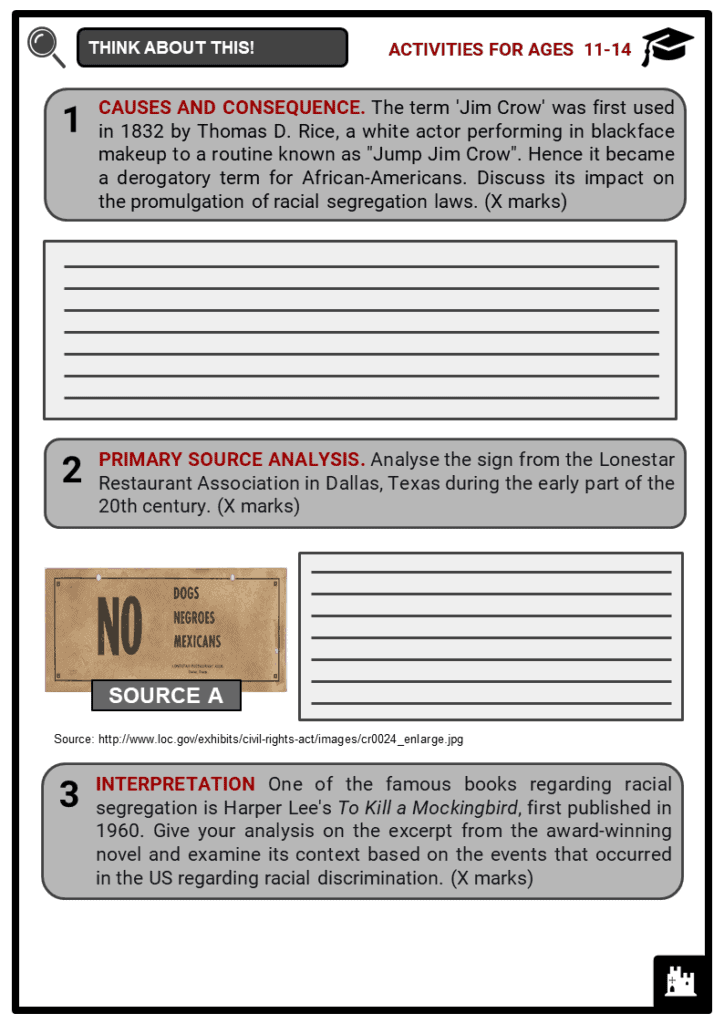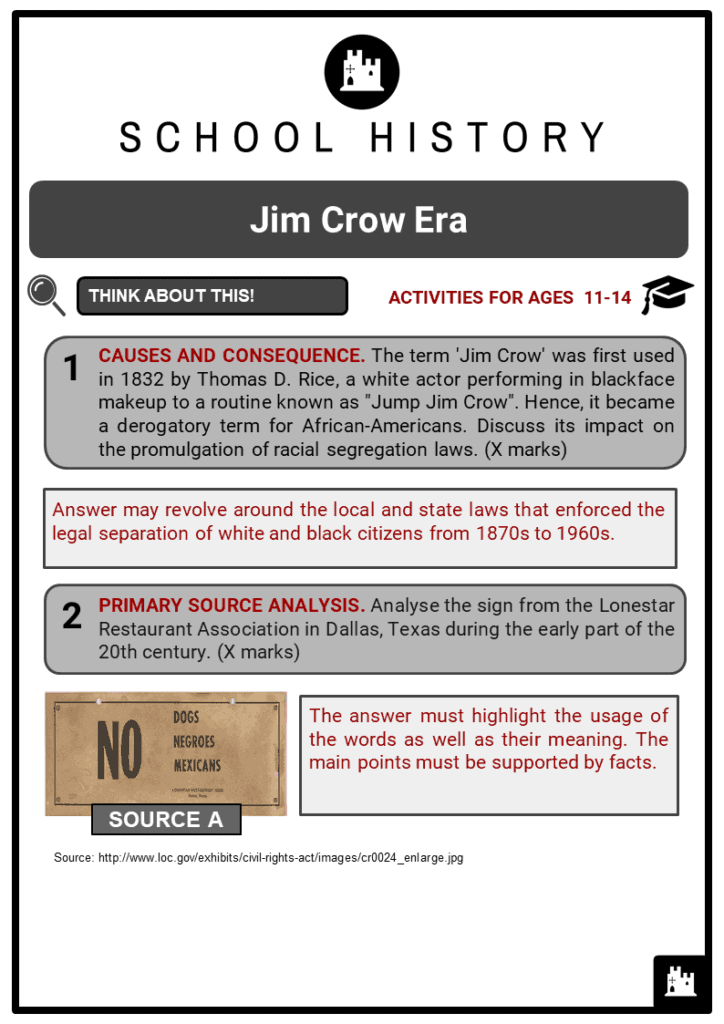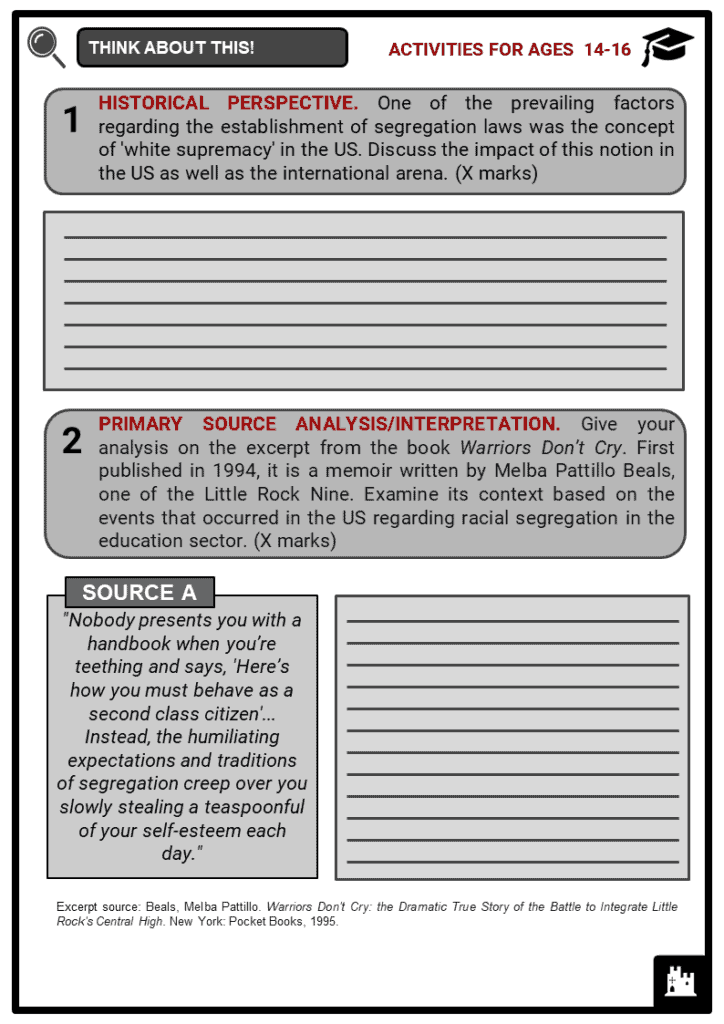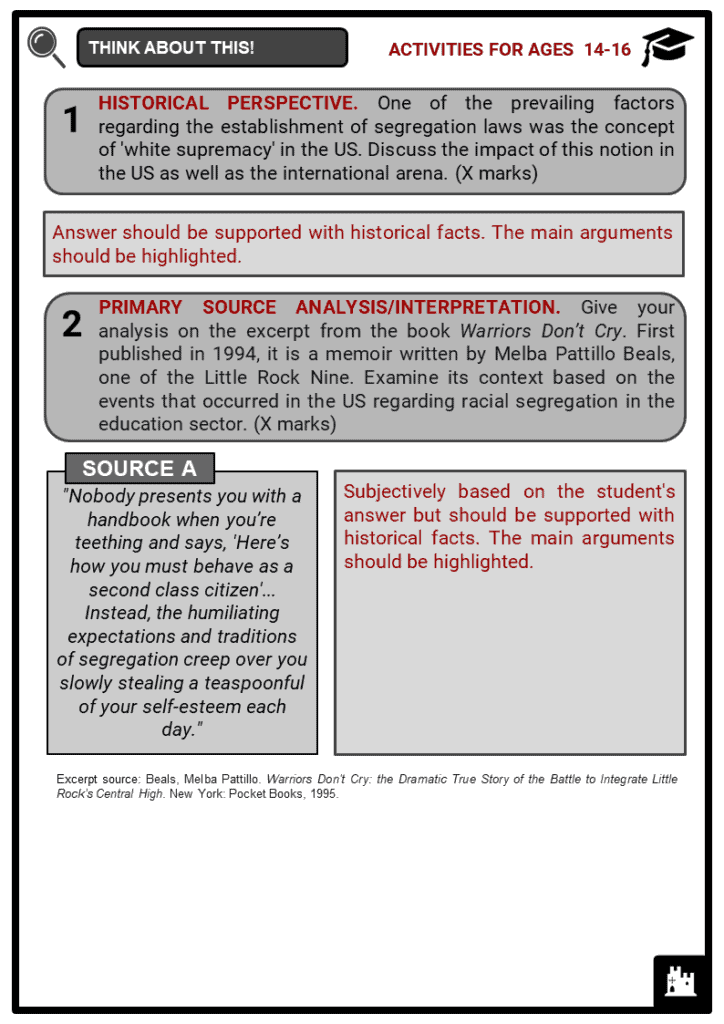Download Jim Crow Era Worksheets
Do you want to save dozens of hours in time? Get your evenings and weekends back? Be able to teach Jim Crow Era to your students?
Our worksheet bundle includes a fact file and printable worksheets and student activities. Perfect for both the classroom and homeschooling!
Table of Contents
Add a header to begin generating the table of contents
Summary
- The context behind the establishment of Jim Crow laws
- The content of the Jim Crow laws
- Significant events that led to the downfall of the Jim Crow Era
Key Facts And Information
Let’s find out more about the Jim Crow Era!
- The Jim Crow Era was established towards the end of the Reconstruction Period until the end of 1965 with the enactment of the Voting Rights Act. The system was in place despite the Fourteenth Amendment, which granted citizenship to African-Americans in 1868, and the Fifteenth Amendment that granted universal male suffrage to black people.
Establishment of the Jim Crow System
- Crows are blackbirds and the name Crow was the last name of the standard fictional black character played by a white man in blackface makeup from the early to mid-19th century. The name was first used in 1832 by Thomas D. Rice, a white actor performing in blackface makeup to a routine known as “Jump Jim Crow.” Jim Crow was, therefore, a derogatory term for African-Americans.
- The Jim Crow System started towards the end of the Reconstruction Period until the end of 1965 with the enactment of the Voting Rights Act. At the time, Jim Crow was a term used as a synonym for racial segregation, referring to local and state laws that enforced the legal separation of white and black citizens from the 1870s to the 1960s.
- The Black Codes of 1865, created after the abolition of slavery by the thirteenth amendment and the actions of the Ku Klux Klan (KKK), are precursors to the Jim Crow laws. The former laws ensured that the systematic oppression of Black people was legalised even with the constitutional amendment that the KKK was a terrorist group that was meant to suppress any form of black excellence.
- Racial segregation through the Jim Crow System was a way of life. During this period it was illegal for African-Americans to ride in the front of public buses and eat at “white only” restaurants or attend “white” public schools. The same applied to other public spaces such as cemeteries, theatres and parks where black and white people were not allowed to mix.
- In addition to the segregation laws, laws prohibited African-Americans from voting by providing for election taxes, literacy tests and grandfather clauses.
- Louisiana, North Carolina, Alabama, Georgia, Maryland, Oklahoma and Virginia were states with the grandfather clauses which provided that those able to vote before 1867, or whose fathers or grandfathers could vote before then, were exempt from tests and taxes that qualified persons to vote. This was within the context of the Fourteenth Amendment, which granted citizenship to African-Americans in 1868, and the Fifteenth Amendment that granted universal male suffrage to black people.
- The social implication of the laws meant that black people were also required to act in a subversive manner, reflecting their supposed inferiority to whites:
- Black businessmen would often find their businesses razed to the ground by jealous white folk.
- Black men were also hanged for having romantic relations with white people, and black women were expected to step off the pavement for a white person to pass.
- Black people were also denied the space to express any form of black pride.
- To escape the harsh segregation laws in the South, black people continued to move to the northern and western part of the US. However, they were faced with other laws and attitudes that barred black people from forming and joining specific types of unions or finding employment in industries that were the preserve of white employees.
- Despite the discrimination, in 1896, African-American women established the National Association of Coloured Women that advocated for women's suffrage and the progression of other forms of civil rights. In 1905, W.E.B. Du Bois and William Monroe Trotter created the Niagara Movement that mobilised black people all over the country to fight against racial inequality. The Niagara Movement went on to become the National Association for the Advancement of Coloured People (NAACP) that fought against social and racial bias through legislative advocacy, court cases and public protests.
The Fall of the Jim Crow System
- The black community put up a spirited campaign against the segregation laws, taking apart the Jim Crow System little by little. In 1887 the first black settlement was established in Mound Bayou, Mississippi by Isaiah Montgomery. Together with other black people and formerly enslaved people, Montgomery cleared the land and created a peaceful community.
- In 1892, Homer Plessy was arrested for boarding a whites-only compartment on a train and arrested upon refusal to move to the section for black people. The matter, as was initially intended by Plessy, found its way to the US Supreme Court in 1896, challenging the constitutionality of the segregation laws in Louisiana, contrary to the Fourteenth Amendment.
- The Supreme Court held that the segregation laws did not violate the Fourteenth Amendment as long as the separate accommodations for white and black people were equal. Summarising the majority ruling, Justice Henry Brown implied that the black people’s perception of inequality in the segregation laws was based on their inferiority complex and not the rules themselves.
- In 1901 Charlotte Hawkins Brown founded the first black school in North Carolina by fundraising among the black community, after the government withdrew funding for the Alice Freeman Palmer Memorial Institute.
- Franklin D. Roosevelt enacted the Fair Employment Act through the 1904 Executive Order 8802 that dealt a significant blow to the Jim Crow System. The primary objective of the regulation passed during the Second World War was to desegregate employment in war industries following pressure from Civil Rights groups under the leadership of A. Philip Randolph.
- In 1947, Jackie Robinson joined the Brooklyn Dodgers baseball team, and in the following year, President Truman issued an executive order ending segregation in the armed forces. In 1954, in the case of Brown vs Board of Education of Topeka, the Supreme Court found that segregated facilities were “inherently unequal”, effectively overturning the Plessy decision.
- In 1951, Oliver Brown filed a suit against the Board of Education of Topeka when his daughter, Linda Brown, was refused admittance to the public school closest to their home and required her to attend an all-black school further from their home. Brown claimed segregation in schools violated the Fourteenth Amendment's “equal protection clause”. Several cases with similar lawsuits were combined with them and the district court ruled in favour of the school board based on the 1896 Plessy v. Ferguson case. It stipulated that segregation in facilities were valid as long they followed the doctrine of "separate but equal".
- After the historic success of the Brown vs Board of Education of Topeka case, racial segregation in schools was deemed unconstitutional. However, in Little Rock Central High School in Arkansas, Governor Orval Faubus ordered the Arkansas National Guard to block nine African-American students from entering the school on the 4th of September 1957 - the first day of classes.
- President Dwight D. Eisenhower intervened by issuing Executive Order 10730 in which National Guardsmen should support the school integration on the 23rd of September 1957 by protecting the African-American students known as the Little Rock Nine. Ernest Green, a senior among the nine students, graduated on the 25th of May 1958, the first African-American student to do so.
- In 1955 Rosa Parks, a seamstress and the NAACP secretary, refused to give up her seat on a public bus, leading to the Montgomery Bus Boycott which lasted over a year, giving rise to the modern Civil Rights Movement.
- Rosa Parks inspired the African-American community and she became a symbol of the Civil Rights Movement. The US Congress named her the 'first lady of civil rights' and 'the mother of the freedom movement'. As she was the secretary of the NAACP Montgomery chapter, Parks helped in training activists for civil rights. Furthermore, she collaborated with prominent civil rights leaders such as Martin Luther King, Jr.
- In 1960, the Congress for Racial Equality (CORE) and the Student Nonviolent Coordinating Committee (SNCC), focused on organising peaceful opposition to racial discrimination laws and attitudes throughout the US. In 1964, 1965 and 1968, the Civil Rights Act, the Voting Rights Act and the Fair Housing Act respectively were enacted, bringing an end to the Jim Crow System.

